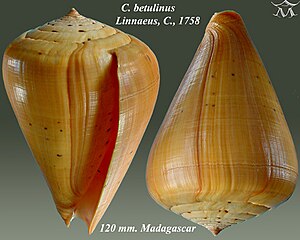Birch cone
| Birch cone snail | ||||||||||||
|---|---|---|---|---|---|---|---|---|---|---|---|---|

Conus betulinus |
||||||||||||
| Systematics | ||||||||||||
|
||||||||||||
| Scientific name | ||||||||||||
| Conus betulinus | ||||||||||||
| Linnaeus , 1758 |
The birch cone or Birch cone shell ( Conus betulinus ) is a screw from the family of the cone snails (genus Conus ), which in Indopazifik is widespread and of bristle worms fed.
features
Conus betulinus has a moderately large to large, firm to heavy snail shell , which in adult snails reaches 5.5 to 18 cm in length. The circumference of the body is bulbous-conical to broadly bulbous-conical, more rarely completely conical, broadly conical or approximately pear-shaped, the outline mostly straight in the two thirds facing away from the apex and convex to strongly convex in the third towards the apex, at the other end occasionally slightly concave . The shoulder is almost angled to rounded. The thread is low to moderately high, its contour is alternately concave. The seam ramps of the Teleoconch are flat to slightly convex with numerous spiral lines. Alternating wide spiral ribs run on the surface of the third of the body circumference facing the base.
The basic color of the housing is dark yellow to orange-brown, more rarely cream-colored with yellow or orange spots, occasionally covered with gray. The body is generally covered with spiraling rows of brown drawings, the density and number of which vary and which can also be completely absent. The form of these drawings alternates between narrow spiral lines, rectangular bars, dots, round or square spots and axial spots. Dark drawings alternate regularly with white ones, with the latter often missing on the two-thirds of the surface facing away from the apex. The area around the body at the base may be darker in color. The early seam ramps of the Teleoconch are not speckled, while the later ones can be coated in various ways with dark brown spots, radial stripes and spots. The case mouth is white, sometimes pale yellow or pale purple. In smaller bowls there is a purple-brown shade far inside. The brown, thin to thick, translucent to almost opaque periostracum is covered with fine to strong, interwoven axial ribs.
The foot is dark yellow with violet axial stripes, the rostrum violet, the sipho at the base pale yellow and distal blackish-brown.
The radula teeth , which are connected to a poison gland, have a barb facing away from the tip and opposite a large, only slightly pointed second barb. The number is covered with a double row of strong teeth, which can occupy the entire cutting edge or half of the shaft and ends in a point. The shaft is somewhat constricted in the middle and has a clear spur at the base.
distribution and habitat
Conus betulinus is distributed in the Indo-Pacific from South Africa and Oman to the Ryukyu Islands, New Caledonia , the Solomon Islands and the Australian coast of Queensland , but is absent in the Red Sea. It occurs from the intertidal zone to depths of the sea of 50 m, preferably in the intertidal zone up to 20 m, the form zulu between 30 m and 50 m. It lives in sheltered bays and in reefs on sand and muddy sand.
nutrition
Conus betulinus eats polychaete (Polychaeta), which he shares with his poisonous Radulazähnen stands. It also prey on polychaetes over 1 m in length, but it takes over half an hour to eat such a large prey.
literature
- Alan J Kohn (1978): The Conidae (Mollusca: Gastropoda) of India. Journal of Natural History 12, pp. 295-335.
- George Washington Tryon: Manual of Conchology, structural and systematic, with illustrations of the species , vol. VI; Academy of Natural Sciences, Philadelphia 1884. C [onus] betulinus Linn., P. 16.
- Jerry G. Walls: Cone Shells: A Synopsis of the Living Conidae TFH Publications, Neptune (New Jersey) 1979. pp. 218f.
Web links
- Conus (Dendrocons) betulinus Linnaeus, 1758. António Monteiro, The Cone Collector, 2011.
Individual evidence
- ↑ Baldomero M. Olivera, Patrice Showers Corneli, Maren Watkins, Alexander Fedosov (2014): Biodiversity of Cone Snails and Other Venomous Marine Gastropods: Evolutionary Success Through Neuropharmacology. Annual Review of Animal Biosciences 2014 (2), pp. 487-513, here 505.